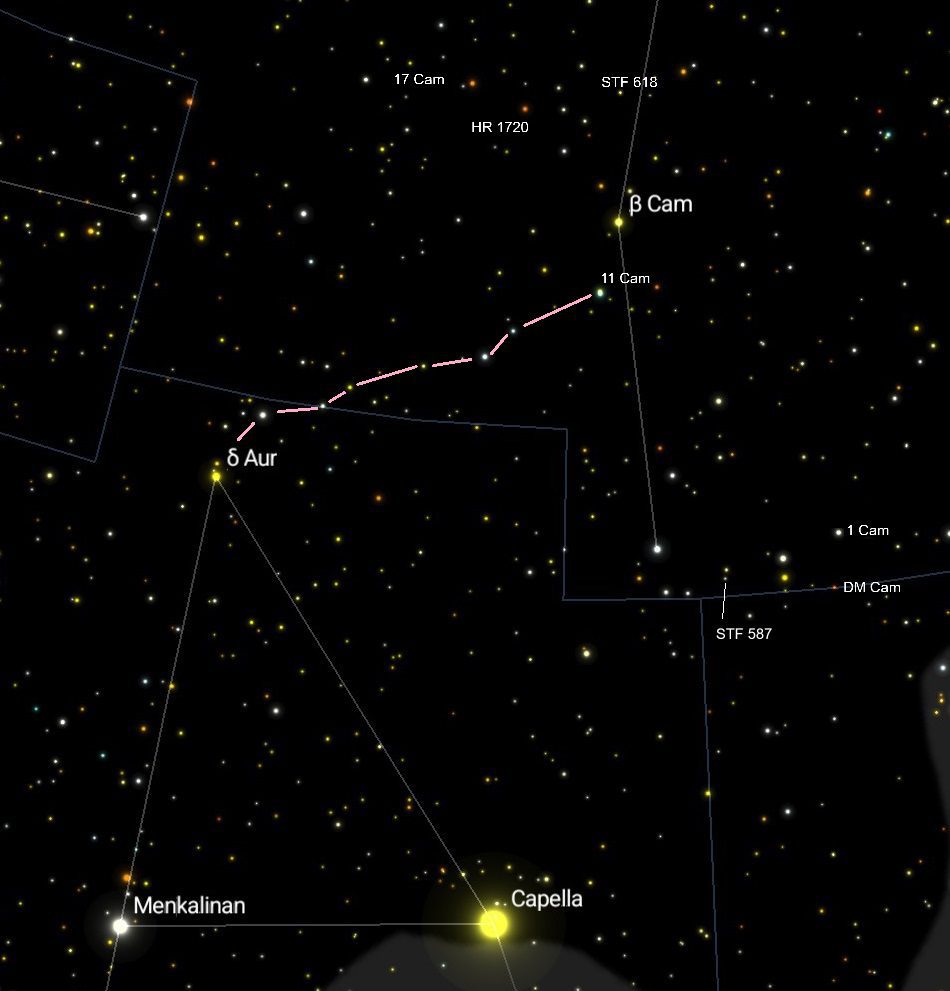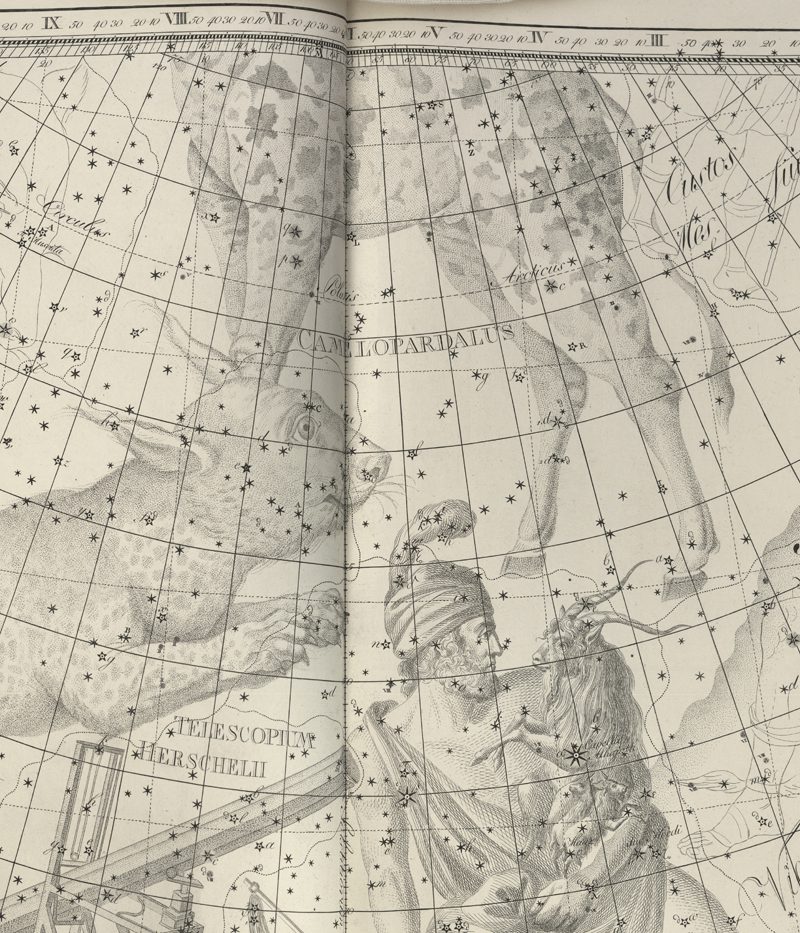This time of year I find myself visiting Camelopardalis (really a giraffe not a camel — see this post from last winter). Despite its large size (18th largest constellation), Camelopardalis attracts relatively few astronomical caravans (having a hard time shaking the camel-vibe) because it is lacking in bright stars. (I almost said dim.) Its brightest star is 4th magnitude Beta Camelopardalis. Seeing any star in the constellation naked-eye from an urban location requires a clear sky on a moonless night. A fun challenge though for astronomically inclined urbanites. Knowing precisely where to look is no small part of detecting Beta. The constellation includes a few more 4th magnitude stars which might be peepable. (Giraffe image courtesy of wikimedia commons.)
Without any bright guide stars, finding celestial gems hidden in the giraffe (and there are quite a few) requires following a trail. Also known as star hopping. Made more challenging for urban observers because none of the stars in the constellation is easy to see naked eye, which means facing our fears and star hopping with binoculars.

The Sky Safari chart above shows the star fields explored in this post, while the Bode Uranometria plate 5 detail below shows the relative position of Camelopardalis. The giraffe’s head, near Polaris, is found on Uranometria plate 3.

For this foray I started from Delta Aurigae, which at 3.73 magnitude can just be seen naked eye in urban skies, even with a waxing gibbous moon in the sky. In addition, it is easy to triangulate the location of Delta from the brilliant stars Capella and Menkalinan. Capella is the 6th brightest star in the sky at 0.08 magnitude and relatively close to our solar system at a distance of 42.9 light years. With hand held binoculars a trail of bright stars (pink line above) leads from Delta Aurigae to the outstanding binocular double formed by 11 and 12 Camelopardalis. The trail of stars is readily seen on the Bode Uranometria plate.
STFA 13 / 11 and 12 Camelopardalis
05h06m +58*58′
5.20/6.21 sep 177.7″ pa 9.5*
Distance: 686 LY / 705 LY
Spectral Type: B3Ve / K0IIIe
Color Index: -0.12 blue-white / +1.13 orange
Easily resolved with hand held binoculars, even lower magnification. This is a fine object for mounted 10x binoculars and also for binocular telescopes — I viewed it with the Oberwerk 70XL-ED at 19.5x (with 20mm eyepieces). Fine colors of light blue and deep yellow in all instruments.
Just to the north, the afore mentioned Beta Camelopardalis (10 Cam) is another fine binocular double.
S 459 / Beta Camelopardalis
05h03m +60*27′
4.12/7.44 sep 84.2″ pa 209.1*
Distance: 686.5 / 476.1 LY
Spectral Type: G1Ib / A5
Color Index: +0.93 yellow-orange / +0.25 yellow-white
Bright yellow primary with a diminutive white companion at a generous distance. Best seen with mounted binoculars and BTs.
The double star STF 618 is about 2.5 degrees north of Beta Cam. An asterism of three 6th magnitude stars (including 14 Cam) near the double forms a right triangle, the baseline of which points toward it. To the west of the asterism can be seen two coppery orange 5th magnitude stars, 17 Camelopardalis and HR 1720.
STF 618
05h03m +63*05′
7.68/7.98 sep 33.3″ pa 211*
A pair of evenly-matched yellowish stars at a friendly distance. The primary is slightly brighter.
STF 617
05h03m +63*05′
9.24/9.82 sep 12.6″ pa 121.4*
In the same field with STF 618. Close but not tight with the 100XL-SD at 62x. Both stars white. I can just resolve it with the 70XL at 19.5x, but would have overlooked it if I hadn’t seen it with the 100XL first.
Returning to Beta and the pair of 11/12 Camelopardalis, and then traveling 6*44′ to the south brings one to the 4.46 magnitude star 7 Camelopardalis, another that might possibly be glimpsed naked eye in urban skies if one knows precisely where to look. Just to the east are the 5th magnitude stars 2 and 3 Camelopardalis, a pleasing white and yellow duo easily seen with hand held binoculars. Grouped around the trio of 7, 2, and 3 Cam are four more pleasing binocular double stars.
STF 558 / 1 Camelopardalis
04h32m +53*55′
5.78/6.82 sep 10.378″ pa 308.2*
Gorgeous with the 70XL at 19.5x. Both stars brilliant white. Primary much brighter. The stars are nestled together but fully resolved. With the 100XL at 62x, I see the primary as yellow and the secondary white.
D 4
04h40m +53*28′
8.96/10.30 sep 5.83″ pa 264*
Nicely resolved with the 100XL. That’s it? (My only journal note.) 😆I’ll need to revisit D4 and take a few more notes. The “D” discoverer code is for Ercole (Hercules) Dembowski (1812-1881), said to be a tireless observer of double stars. D 4 was discovered in 1867.
STF 587
04h48m +53*07′
7.59/9.15 sep 21″ pa 185*
A delicately beautiful double star. One corner of an elongated quadrilateral. Cozy but not tight. Primary much brighter. Both stars white.
ES 2607 / DM Camelopardalis
04h33m +52*48′
7.45/9.48 sep 47″ pa 130.7*
Deep yellow primary with a faint companion at a comfortable distance.


Great post! Thanks for these. I appreciate the time and attention. I just discovered they make astronomy focused “baseball” cards. If you would like to buy a Camlopardalis card search ebay for the below (don’t want to link to it as it will look like I’m scamming you). Sadly they don’t have a Lyra card, my favorite constellation but that did inspire and I found a ring nebula “cigarette card” from the 1920s!
2022 Upper Deck Cosmic Constellations Camlopardalis #CON-13
Thanks for the tip about the astronomy cards, Carter. I’ll take a look. I’m glad you enjoy this blog. 🙂